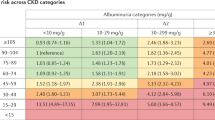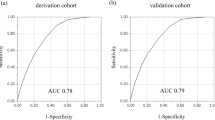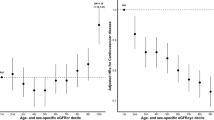Abstract
Biomarkers are a useful tool for the investigation of chronic kidney disease (CKD), although the design, analytical tools and outcomes used in many biomarker studies are suboptimal. In part, this situation might reflect a lack of appreciation of the nature of different biomarkers. A particular biomarker could, for example, be implicated in the pathogenesis of CKD because it is a physiological risk factor for declining kidney function, an indicator of impaired kidney function, or a marker of ongoing injury within the kidney. Such risk factors enable us to understand the process of disease and to identify treatment targets. By contrast, risk markers enable us to distinguish persons who will or will not develop CKD, even though the markers themselves are not required to be modifiable by (or directly involved in) the disease process. Accurate prediction of CKD risk will probably require a combination of biomarkers of several types, however. This Review offers a conceptual framework for interpreting the results of studies evaluating biomarkers of declining kidney function and incident CKD.
Key Points
-
Biomarkers can be classified as either risk factors, injury makers, or tools for risk prediction
-
A conceptual framework for interpreting results of biomarker studies in chronic kidney disease (CKD) can be generated
-
Our particular framework classifies biomarkers for CKD into four different categories: susceptibility factors, systemic risk factors, injury biomarkers, and biomarkers of early loss of glomerular filtration rate
-
It is likely that a combination of biomarkers will be required to improve risk prediction for the development of CKD
This is a preview of subscription content, access via your institution
Access options
Subscribe to this journal
Receive 12 print issues and online access
$209.00 per year
only $17.42 per issue
Buy this article
- Purchase on Springer Link
- Instant access to full article PDF
Prices may be subject to local taxes which are calculated during checkout


Similar content being viewed by others
References
Vasan, R. S. Biomarkers of cardiovascular disease: molecular basis and practical considerations. Circulation 113, 2335–2362 (2006).
Biomarkers Definitions Working Group. Biomarkers and surrogate endpoints: preferred definitions and conceptual framework. Clin. Pharmacol. Ther. 69, 89–95 (2001).
National Kidney Foundation. K/DOQI clinical practice guidelines for chronic kidney disease: evaluation, classification, and stratification. Kidney Disease Outcome Quality Initiative. Am. J. Kidney Dis. 39, S1–S246 (2002).
Coresh, J. et al. Prevalence of chronic kidney disease in the United States. JAMA 298, 2038–2047 (2007).
Pepe, M. S., Feng, Z., Janes, H., Bossuyt, P. M. & Potter, J. D. Pivotal evaluation of the accuracy of a biomarker used for classification or prediction: standards for study design. J. Natl Cancer Inst. 100, 1432–1438 (2008).
Pencina, M. J., D'Agostino, R. B. Sr & Steyerberg, E. W. Extensions of net reclassification improvement calculations to measure usefulness of new biomarkers. Stat. Med. 30, 11–21 (2011).
Pencina, M. J., D'Agostino, R. B. & Vasan, R. S. Statistical methods for assessment of added usefulness of new biomarkers. Clin. Chem. Lab. Med. 48, 1703–1711 (2010).
Pencina, M. J., D'Agostino, R. B., Pencina, K. M., Janssens, A. C. & Greenland, P. Interpreting incremental value of markers added to risk prediction models. Am. J. Epidemiol. 176, 473–481 (2012).
Pencina, M. J., D'Agostino, R. B. Sr, D'Agostino, R. B. Jr & Vasan, R. S. Evaluating the added predictive ability of a new marker: from area under the ROC curve to reclassification and beyond (discussion). Stat. Med. 27, 207–212 (2008).
Pepe, M. S. Problems with risk reclassification methods for evaluating prediction models. Am. J. Epidemiol. 173, 1327–1335 (2011).
Janes, H., Pepe, M. S. & Gu, W. Assessing the value of risk predictions by using risk stratification tables. Ann. Intern. Med. 149, 751–760 (2008).
Kottgen, A. et al. Multiple loci associated with indices of renal function and chronic kidney disease. Nat. Genet. 42, 376–384 (2009).
Papeta, N. et al. APOL1 variants increase risk for FSGS and HIVAN but not IgA nephropathy. J. Am. Soc. Nephrol. 22, 1991–1996 (2011).
Kopp, J. B. et al. APOL1 genetic variants in focal segmental glomerulosclerosis and HIV-associated nephropathy. J. Am. Soc. Nephrol. 22, 2129–2137 (2011).
Friedman, D. J., Kozlitina, J., Genovese, G., Jog, P. & Pollak, M. R. Population-based risk assessment of APOL1 on renal disease. J. Am. Soc. Nephrol. 22, 2098–2105 (2011).
Xu, R. & Zuo, L. Low birthweight and chronic kidney disease. Nephrology (Carlton) 15 (Suppl. 2), 18–22.
Li, S. et al. Low birth weight is associated with chronic kidney disease only in men. Kidney Int. 73, 637–642 (2008).
Soderland, P., Lovekar, S., Weiner, D. E., Brooks, D. R. & Kaufman, J. S. Chronic kidney disease associated with environmental toxins and exposures. Adv. Chronic Kidney Dis. 17, 254–264 (2010).
Elinder, C. G. & Alvestrand, A. Environmental lead exposure and chronic renal disease (author reply). N. Engl. J. Med. 348, 1810–1812 (2003).
Shlipak, M. G. et al. Clinical and subclinical cardiovascular disease and kidney function decline in the elderly. Atherosclerosis 204, 298–303 (2008).
Hiramoto, J. S. et al. Inflammation and Coagulation Markers and Kidney Function Decline: The Multi-Ethnic Study of Atherosclerosis. Am. J. Kidney Dis. 60, 225–232 (2012).
Yu, Y. et al. Urinary biomarkers trefoil factor 3 and albumin enable early detection of kidney tubular injury. Nat. Biotechnol. 28, 470–477 (2010).
Yamamoto, T. & Noble, N. A. Sustained expression of TGF-β1 underlies development of progressive kidney fibrosis. Kidney Int. 45, 916–927 (1994).
Wada, T. et al. Monitoring urinary levels of monocyte chemotactic and activating factor reflects disease activity of lupus nephritis. Kidney Int. 49, 761–767 (1996).
Peralta, C. A. et al. The associations of urinary levels of kidney injury molecule-1 (KIM-1) and neutrophil gelatinase-associated lipocalin (NGAL) with kidney function decline in the multi-ethnic study of atherosclerosis (MESA). Am. J. Kidney Dis. 60, 904–911 (2012).
Astor, B. C. et al. Trefoil factor 3 predicts incident chronic kidney disease: a case-control study nested within the Atherosclerosis Risk in Communities (ARIC) study. Am. J. Nephrol. 34, 291–297 (2011).
Bleyer, A. J., Hart, T. C., Shihabi, Z., Robins, V. & Hoyer, J. R. Mutations in the uromodulin gene decrease urinary excretion of Tamm-Horsfall protein. Kidney Int. 66, 974–977 (2004).
Kottgen, A. et al. Uromodulin levels associate with a common UMOD variant and risk for incident CKD. J. Am. Soc. Nephrol. 21, 337–344 (2010).
Shlipak, M. G. et al. Uromodulin concentrations are not associated with incident CKD among persons with coronary artery disease. BMC Nephrol. 12, 2 (2011).
Torabinejad, S. et al. Urinary monocyte chemotactic protein-1 and transforming growth factor-β in systemic lupus erythematosus. Indian J. Nephrol. 22, 5–12 (2012).
O'Seaghdha, C. M. et al. Lower urinary connective tissue growth factor levels and incident CKD stage 3 in the general population. Am. J. Kidney Dis. 57, 841–849 (2011).
Shastri, S. et al. Cystatin C and albuminuria as risk factors for development of CKD stage 3: the Multi-Ethnic Study of Atherosclerosis (MESA). Am. J. Kidney Dis. 57, 832–840 (2011).
Fox, C. S. et al. A multi-marker approach to predict incident CKD and microalbuminuria. J. Am. Soc. Nephrol. 21, 2143–2149 (2010).
Acknowledgements
The authors acknowledge research grant support (M. G. Shlipak as principal investigator) from the National Institutes of Health, Bethesda, MD, USA (5R01AG034853-04; 5R01AG027002-07; 5R01DK087961-02).
Author information
Authors and Affiliations
Contributions
M. G. Shlipak and E. C. Day contributed equally to all aspects of the manuscript, including researching data for the article, writing the manuscript and review or editing of the manuscript before submission.
Corresponding author
Ethics declarations
Competing interests
The authors declare no competing financial interests.
Rights and permissions
About this article
Cite this article
Shlipak, M., Day, E. Biomarkers for incident CKD: a new framework for interpreting the literature. Nat Rev Nephrol 9, 478–483 (2013). https://doi.org/10.1038/nrneph.2013.108
Published:
Issue Date:
DOI: https://doi.org/10.1038/nrneph.2013.108
This article is cited by
-
Biomarkers of kidney injury among children in a high-risk region for chronic kidney disease of uncertain etiology
Pediatric Nephrology (2021)
-
Assessing the recovery from prerenal and renal acute kidney injury after treatment with single herbal medicine via activity of the biomarkers HMGB1, NGAL and KIM-1 in kidney proximal tubular cells treated by cisplatin with different doses and exposure times
BMC Complementary and Alternative Medicine (2017)
-
Uromodulin: from physiology to rare and complex kidney disorders
Nature Reviews Nephrology (2017)
-
The extracellular matrix in the kidney: a source of novel non-invasive biomarkers of kidney fibrosis?
Fibrogenesis & Tissue Repair (2014)



